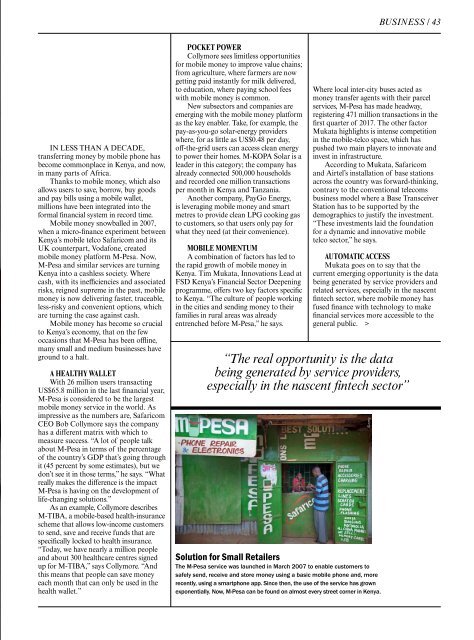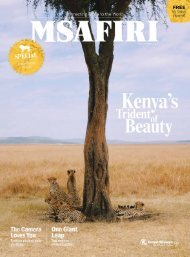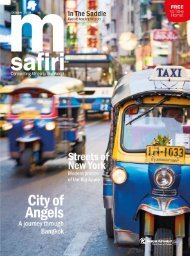You also want an ePaper? Increase the reach of your titles
YUMPU automatically turns print PDFs into web optimized ePapers that Google loves.
BUSINESS / 43<br />
IN LESS THAN A DECADE,<br />
transferring money by mobile phone has<br />
become commonplace in Kenya, and now,<br />
in many parts of Africa.<br />
Thanks to mobile money, which also<br />
allows users to save, borrow, buy goods<br />
and pay bills using a mobile wallet,<br />
millions have been integrated into the<br />
formal financial system in record time.<br />
Mobile money snowballed in 2007,<br />
when a micro-finance experiment between<br />
Kenya’s mobile telco Safaricom and its<br />
UK counterpart, Vodafone, created<br />
mobile money platform M-Pesa. Now,<br />
M-Pesa and similar services are turning<br />
Kenya into a cashless society. Where<br />
cash, with its inefficiencies and associated<br />
risks, reigned supreme in the past, mobile<br />
money is now delivering faster, traceable,<br />
less-risky and convenient options, which<br />
are turning the case against cash.<br />
Mobile money has become so crucial<br />
to Kenya’s economy, that on the few<br />
occasions that M-Pesa has been offline,<br />
many small and medium businesses have<br />
ground to a halt.<br />
A HEALTHY WALLET<br />
With 26 million users transacting<br />
US$65.8 million in the last financial year,<br />
M-Pesa is considered to be the largest<br />
mobile money service in the world. As<br />
impressive as the numbers are, Safaricom<br />
CEO Bob Collymore says the company<br />
has a different matrix with which to<br />
measure success. “A lot of people talk<br />
about M-Pesa in terms of the percentage<br />
of the country’s GDP that’s going through<br />
it (45 percent by some estimates), but we<br />
don’t see it in those terms,” he says. “What<br />
really makes the difference is the impact<br />
M-Pesa is having on the development of<br />
life-changing solutions.”<br />
As an example, Collymore describes<br />
M-TIBA, a mobile-based health-insurance<br />
scheme that allows low-income customers<br />
to send, save and receive funds that are<br />
specifically locked to health insurance.<br />
“Today, we have nearly a million people<br />
and about 300 healthcare centres signed<br />
up for M-TIBA,” says Collymore. “And<br />
this means that people can save money<br />
each month that can only be used in the<br />
health wallet.”<br />
POCKET POWER<br />
Collymore sees limitless opportunities<br />
for mobile money to improve value chains;<br />
from agriculture, where farmers are now<br />
getting paid instantly for milk delivered,<br />
to education, where paying school fees<br />
with mobile money is common.<br />
New subsectors and companies are<br />
emerging with the mobile money platform<br />
as the key enabler. Take, for example, the<br />
pay-as-you-go solar-energy providers<br />
where, for as little as US$0.48 per day,<br />
off-the-grid users can access clean energy<br />
to power their homes. M-KOPA Solar is a<br />
leader in this category; the company has<br />
already connected 500,000 households<br />
and recorded one million transactions<br />
per month in Kenya and Tanzania.<br />
Another company, PayGo Energy,<br />
is leveraging mobile money and smart<br />
metres to provide clean LPG cooking gas<br />
to customers, so that users only pay for<br />
what they need (at their convenience).<br />
MOBILE MOMENTUM<br />
A combination of factors has led to<br />
the rapid growth of mobile money in<br />
Kenya. Tim Mukata, Innovations Lead at<br />
FSD Kenya’s Financial Sector Deepening<br />
programme, offers two key factors specific<br />
to Kenya. “The culture of people working<br />
in the cities and sending money to their<br />
families in rural areas was already<br />
entrenched before M-Pesa,” he says.<br />
Where local inter-city buses acted as<br />
money transfer agents with their parcel<br />
services, M-Pesa has made headway,<br />
registering 471 million transactions in the<br />
first quarter of <strong>2017</strong>. The other factor<br />
Mukata highlights is intense competition<br />
in the mobile-telco space, which has<br />
pushed two main players to innovate and<br />
invest in infrastructure.<br />
According to Mukata, Safaricom<br />
and Airtel’s installation of base stations<br />
across the country was forward-thinking,<br />
contrary to the conventional telecoms<br />
business model where a Base Transceiver<br />
Station has to be supported by the<br />
demographics to justify the investment.<br />
“These investments laid the foundation<br />
for a dynamic and innovative mobile<br />
telco sector,” he says.<br />
AUTOMATIC ACCESS<br />
Mukata goes on to say that the<br />
current emerging opportunity is the data<br />
being generated by service providers and<br />
related services, especially in the nascent<br />
fintech sector, where mobile money has<br />
fused finance with technology to make<br />
financial services more accessible to the<br />
general public. ><br />
“The real opportunity is the data<br />
being generated by service providers,<br />
especially in the nascent fintech sector”<br />
Solution for Small Retailers<br />
The M-Pesa service was launched in March 2007 to enable customers to<br />
safely send, receive and store money using a basic mobile phone and, more<br />
recently, using a smartphone app. Since then, the use of the service has grown<br />
exponentially. Now, M-Pesa can be found on almost every street corner in Kenya.<br />
Alamy

















